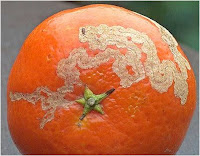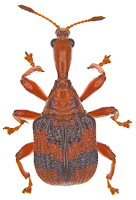Grape
vine
1. Grapevine stem girdler: Sthenias grisator :Cerambycidae: Coleoptera.
- Hosts: Rose-bushes, mulberry, garden shrubs, creepers, crotons, mango, almond, jack-fruit, bougainvillea and Indian ash-tree.
- Eggs are oval and enveloped in a white parchment like covering. Egg period: 8 days
- Grub: Grub has dark brown head and mouth has a pair of prominent mandibles, each with two teeth. Globular thorax with chitinous spines on top.
- Pupa: Grub pupates within the tunnel.
- Adult: Adults are medium-sized, grey coloured beetle with a white spot at the center of each elytron.
- Wilting of branches and then the entire vine.
 |
| Gridling of vein |
- Eggs are laid 4-7 beneath bark or in soil in groups of 20-40. 220-550 eggs/female. Egg period: 4-8 days.
- Grub: Grub period: 34-45 days
- Pupa: Pupate in soil. Pupal period ranges from 7-11 days.
- Adult: Shining flea beetle with a metallic bronze colour and of black patches on elytra.
- Life cycle: 53 days. 3-4 overlapping generations/year.
- Small holes on tender leaves by adult. Root damage by grub.
3. Grapevine thrips: Rhipiphorothrips cruentatus :Thripidae:
Thysanoptera.
- Adult is minute, blackish brown, with yellowish wings.
- Silvery white patches on leaves with black excreta; yellowing and withering in severe infestation
4. Grapevine mealy bug Maconellicoccus hirsutus :Pseudococcidae:
Homoptera.
- Females are pinkish and sparsely covered with white wax.
- Crinkling and yellowing of leaves, rotting of berries.
5. Grapevine
sphingid/Horned caterpillar Hippotion
celerio :Sphingidae: Lepidoptera.
9. Fig
Leaf caterpillar: Hypsa ficus: Hypsidae: Lepidoptera.
- Larva: black with hairs arising from yellowish brown warts.
- Adult: yellow with black dots on the wings. Defoliation.
10. Tamarind
Scale:Aspidiotus
tamarindi: Diaspididae: Hemiptera
v
Yellowish
and circular scales spread over developing fruit.
v
Premature
shedding of buds and flowers, affecting ultimately reduce the fruit setting
capacity of the tree.
11. APPLE
1. Apple woolly aphid: Eriosoma
lanigerum:Pemphegidae:Homoptera.
- Adult: Purple coloured aphids are covered with cottony mats.
- Weakening and death of the smaller plants; galls on the roots; white woolly patches on the trunk.
2. Sanjose scale: Quadraspidiotus
perniciosus:Diaspididae:Homoptera
- Hosts :
Cherry, plum, pear, peach and most other temperate fruit trees.
- Adult: Female scale is yellowish orange, round, slightly convex and raised a little at the centre with a black pustule. Males are small and more linear in shape.
- The infested region in bark becomes reddish pink, purple colouration in fruits.
 |
| Scale insect |
 |
| Purple colouration on fruits |
3. Cottony cushion
scale: Icerya purchasi :Margarodidae: Homoptera.
4. Apple codling moth: Cydia
pomonella:Tortricidae:Lepidoptera.
- Female lays white coloured, flattened eggs, singly on developing fruits, leaves and swings. Egg period: 4-12 days;
- Larval period: 21-30 days; Pupal period: 8-14 days.
- Pupa : Grown up larvae comes out of the fruit and falls on ground and reach the bark of the tree for shelter in cracks and crevices to construct a silken cocoon.
5. Stem borer: Apriona cinerea:Lamiidae:
Coleoptera.
- Female lays eggs inside the cavity, which is excavated on shoots. Egg period: 7-9 days.
- Grubs undergo hibernation during winter and resumes feeding in March.
- Pupa: Pupate inside the tunnel. Pupal period: 30-35 days.
- Adults are ash grey beetles with numerous black tubercles at base of elytra.
- Branches with small circular hole and mass of excreta and chewed up wood particles protruding out; bark gnawed and leaves defoliated; shoots with circuitous galleries; trunk hollowed out and the infested trees remain stunted.











































